Art of the Egypt 1500 Bce Art of the Greece 1000 Bce
Eastwardgyptian art is widely considered to exist one of the most hit art forms to ever exist. The near well-known examples of Egyptian art that accept survived to this mean solar day were produced between the 31st century B.C. and the ivthursday century A.D. Despite seeming antiquated, as art is no longer produced in the same way, ancient Egyptian art remains a fascinating genre to learn near, as the purpose of art then differed profoundly in comparison to what art stands for today.
Tabular array of Contents
- 1 Why Was Egyptian Art And so Of import?
- 2 What Did Aboriginal Egyptian Art Stand For?
- ii.ane Affectionate and Understanding Ancient Egyptian Art
- 2.2 Fine art Non Meant for Public Viewing
- 2.3 The Use of Text and Epitome
- 2.iv The Importance of Scale
- two.5 The Function of Egyptian Art
- ii.half-dozen The Impact of Two-Dimensional Art
- 2.7 The Touch on of Three-Dimensional Art
- three The Chronology of Egyptian Art
- 3.one Pre-Dynastic Egyptian Art (6000 – 3000 B.C.)
- three.2 Early Dynastic Egyptian Art (c. 3150 – 2686 B.C.)
- 4 Characteristics of Egyptian Art
- four.i Anonymity in Egyptian Art
- iv.2 Symbolism in Egyptian Fine art
- iv.3 Symmetry in Egyptian Fine art
- five Types of Egyptian Art
- 5.1 Egyptian Paintings
- v.2 Egyptian Drawings
- 5.3 Egyptian Sculpture
- 6 Iconic Egyptian Artwork
- 6.1 The Great Pyramids of Giza
- vi.2 Pyramid of Khufu
- half dozen.3 Pyramid of Khafre
- 6.4 Pyramid of Menkaure
- 6.5 The Neat Sphinx
- half-dozen.vi Tutankhamun'southward Tomb
- vii Influence and Legacy of Egyptian Art
- 8 Frequently Asked Questions Almost Egyptian Art
- 8.1 What Is Egyptian Art?
- viii.ii What Were the Important Characteristics of Egyptian Fine art?
- 8.3 What Are Some of the Nigh Famous Examples of Egyptian Art?
Why Was Egyptian Art So Important?
The artworks that have come from ancient Egypt take been a topic of keen captivation and obsession for people for thousands of years. This is partly due to the techniques of Egyptian art having inspired both Greek and Roman artists who were influenced by the remarkable sculptures, paintings, drawings, jewelry, and architectural structures that were made.
It has been said that even artworks of sure cultures existing in the present day accept been swayed by the talents of Egyptian art, demonstrating its worldwide affect.
Every bit very little outside influence was able to sway the characteristics of Egyptian fine art, well-nigh of the artworks that were made remained exceptionally stable during the genre's almost 3000-year period. The anonymity associated with artists was an important element within the production of ancient Egyptian art, every bit most of them remain unknown to this twenty-four hour period. This was due to the fact that fine art was more functional equally opposed to aesthetic, every bit it was essentially created for a applied purpose.
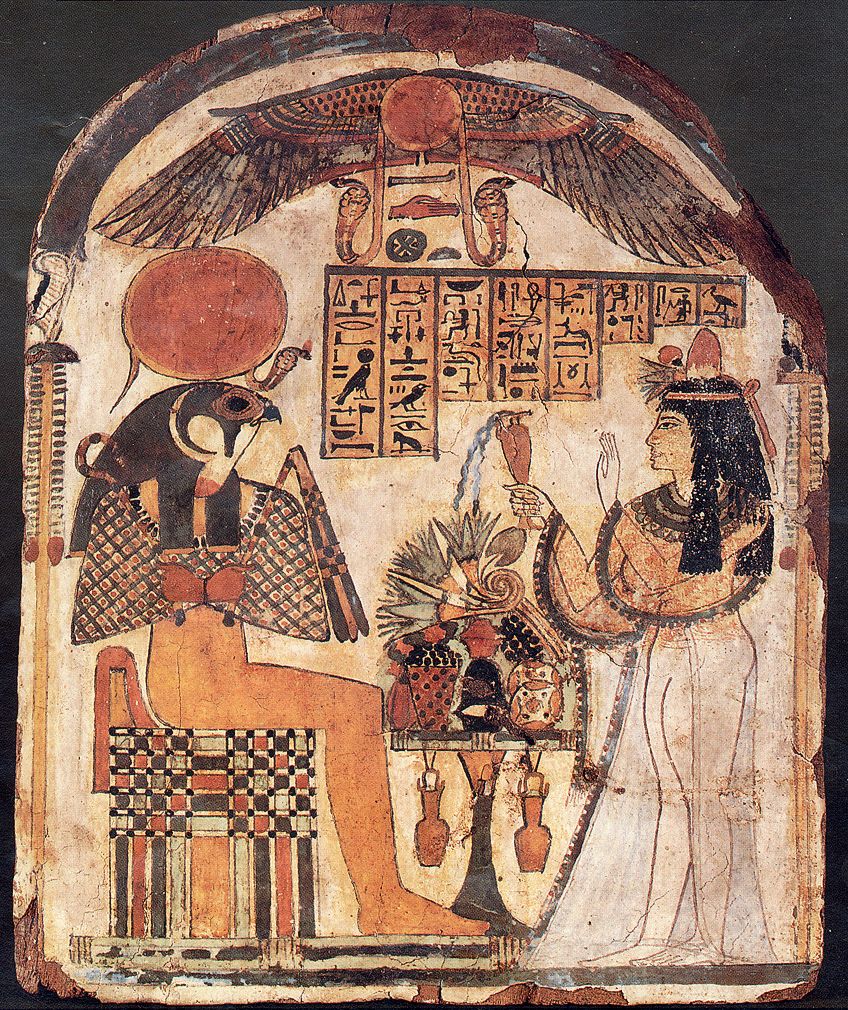 Ancient Egyptian wooden stela depicting Lady Djedkhonsuiwesankh giving offerings of nutrient, drink, and flowers to Re-Horakhty (c. 950–700 BC);Photograph past Oriental Found, the University of Chicago; painter unknown, Public domain, via Wikimedia Commons
Ancient Egyptian wooden stela depicting Lady Djedkhonsuiwesankh giving offerings of nutrient, drink, and flowers to Re-Horakhty (c. 950–700 BC);Photograph past Oriental Found, the University of Chicago; painter unknown, Public domain, via Wikimedia Commons
While more than artists from the later periods of Egyptian art are known by proper name, the artworks that still hold the greatest attractions are those that were fabricated centuries ago by unidentified creatives. This chemical element of curiosity has also added to the cracking intrigue plaguing ancient Egyptian art for then long, equally the artworks differ profoundly from the type of art that is typically produced today.
In social club to recognize the significance of Egyptian fine art, it is important to view the artworks from the perspective of the aboriginal Egyptians themselves.
Despite all of the numerous exhibitions that have featured Egyptian art throughout the years, the artists of the work would never have understood the relevance of placing their work completely out of context in a museum. This was considering art was traditionally made to adorn tombs and was typically reserved for the wealthy who could afford to commission such pieces.
As fourth dimension went on, aboriginal Egyptian fine art reached a substantial level of elegance, with the tombs, temples, tomb paintings, sculptures, and inscriptions condign very stylized and symbolic. This was to emphasize the fact that ancient art served a primarily useful purpose, such as tomb art that represented scenes from one's life on earth and so that one's spirit would be able to recall it. Due to this, the bulk of Egyptian history and civilization has come to be known through the artworks that have been found, which farther indicates their importance.
 Inside the Temple of Philae in Arab republic of egypt, picture from the Clarification De Fifty'Egypte(1821/1822);Jean-Baptiste Lepère, Allais, Public domain, via Wikimedia Commons
Inside the Temple of Philae in Arab republic of egypt, picture from the Clarification De Fifty'Egypte(1821/1822);Jean-Baptiste Lepère, Allais, Public domain, via Wikimedia Commons
However, as only the elite could afford such art, the pieces that accept been found are generally concerned with the lives of the upper grade. It is but through understanding these pieces and stories that those of the lower classes have been exposed, which demonstrated the complication of ancient Egyptian art.
As most of the remaining art that exists today has been establish in tombs and monuments, greater attention on life later on expiry and the conservation of prior data tin be seen. Thus, agreement the importance of Egyptian fine art lies in appreciating what the artworks were actually created for, as they served a vastly dissimilar purpose when compared to the types of art that exist today.
What Did Ancient Egyptian Art Stand up For?
Within any type of civilisation, art has been seen equally a fundamental aspect throughout the centuries. Egypt is no different, with the introduction of artworks existence traced dorsum to the Predynastic Period betwixt 6000 and 3150 B.C.E. Images of animals, humans, and mystical figures have been establish etched onto rock walls, which represents the estimated origin of art within ancient Egypt. While these depictions are seen as unrefined in comparison to the subsequent developments of art, they all limited the of import Egyptian value of balance.
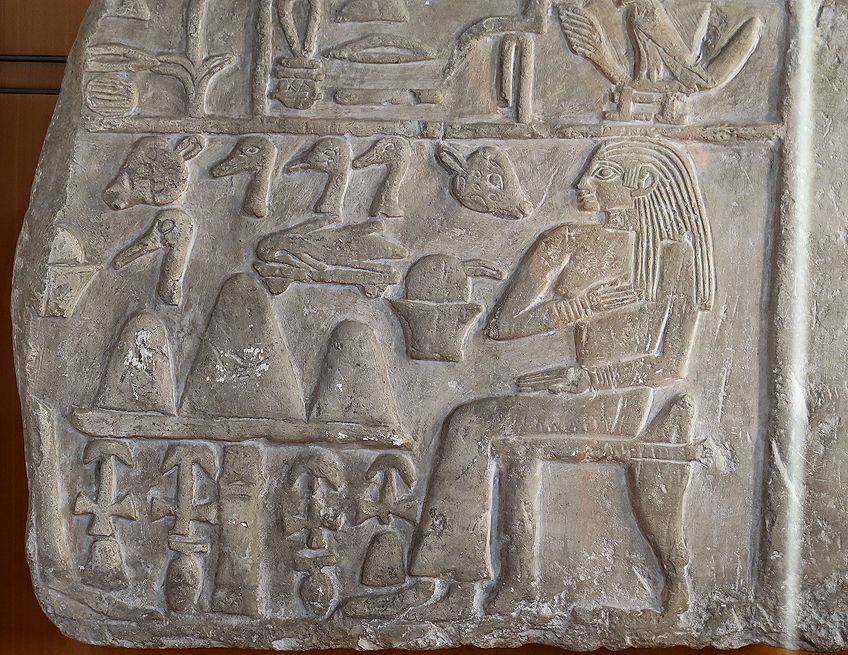 Fragment of a stele in the proper name of Nes-Henou, from the Thinite period, 2nd dynasty (2925-2700 BCE); Ismoon (talk) xix:09, 27 July 2020 (UTC), CC By-SA 4.0, via Wikimedia Commons
Fragment of a stele in the proper name of Nes-Henou, from the Thinite period, 2nd dynasty (2925-2700 BCE); Ismoon (talk) xix:09, 27 July 2020 (UTC), CC By-SA 4.0, via Wikimedia Commons
Starting from the Early Dynastic Period until Roman Egypt when Christianity came in, the blazon of Arab republic of egypt art included ivory sculptures, paintings, papyrus drawings, faience, and jewelry. Additionally, architecture was experimented with, which tin be seen in the iconic pyramids and temples that Egypt is typically known for. Despite so much time passing betwixt the introduction of ancient Egyptian fine art, the style has remained quite conservative and has changed relatively footling in comparison to other art forms.
The bulk of the surviving art that is known near and on display today has come from the excavation of certain tombs and monuments.
Through this, guild has been given more information and agreement into the afterlife principles that were held by the aboriginal Egyptians. For case, the charms and amulets found in these sites were said to protect the deceased from danger, while the figurines protected them from evil spirits and aroused ghosts.
Additionally, the tomb paintings were said to depict scenes from the paradise that those wished to find in the afterlife, with the paintings existing as a blazon of map to aid the departed discover their way. Based on this, we can understand why the artworks produced by the ancient Egyptians served a office as opposed to but existence viewed. As Egyptian artwork was primarily bound in faith and ideology, artists portrayed a very idyllic and unrealistic view of the world every bit no specific creative expression existed since fine art served a wider purpose.
 Nakht and Family Angling and Fowling, Tomb of Nakht (circa 1400 –1390 B.C.);Metropolitan Museum of Fine art, CC0, via Wikimedia Commons
Nakht and Family Angling and Fowling, Tomb of Nakht (circa 1400 –1390 B.C.);Metropolitan Museum of Fine art, CC0, via Wikimedia Commons
As an fine art class, aesthetic beauty was not the incentive behind the creation of about Egyptian artwork. At the time, Egyptian guild was based on the notion of harmony, also known as "ma'at". This led to Egyptian art being created in perfect balance considering it reflected the platonic world of gods.
No matter how beautifully an artwork was crafted, its purpose to serve as a home for a spirit or god was of the utmost importance. Their function was to exist as a reminder of the everlasting nature of life and the value of personal and collective stability.
Appreciating and Understanding Ancient Egyptian Art
In order to truly understand the purpose of ancient Egyptian fine art, the artworks need to exist looked at from the perspective of the Egyptians who produced them. This was considering the art of the Egyptians served a significantly dissimilar intention to the fine art of later cultures and today, as traditional Egyptian art prioritized function over form. This led to the creation of artworks that were quite stable and conventional in design only were also unusually abstract and stocky. Due to this, unflattering comparisons to after styles of Greek and Renaissance art were made, every bit these artworks were more naturalistic in nature.
The comparisons made demonstrated the uniquely different properties that Egyptian art subscribed to when contrasted against other forms of art, which indicated the importance of understanding the aim of Egyptian artwork.
Art Not Meant for Public Viewing
While the artworks that are produced today are generally made to be viewed by an audience, ancient Egyptian art differed profoundly in this regard. Despite the globe marveling at the dazzling treasures found in the tomb of Tutankhamun and the breathtaking reliefs within the New Kingdom tombs, it is important to recollect that ancient Egyptian art was never intended to be seen past others. These artworks were solely made for the deceased, every bit their only purpose was to guide the spirit in the afterlife and decorate the tomb.
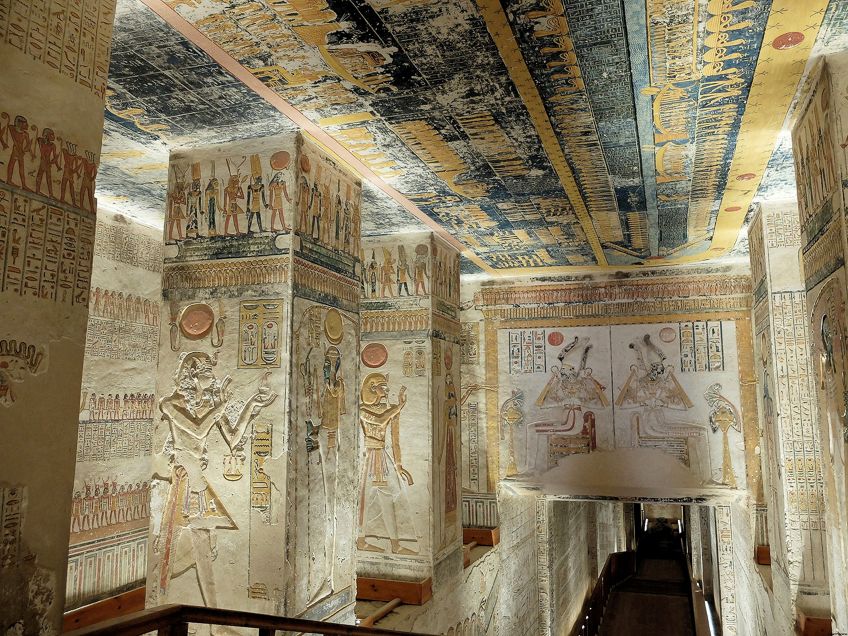 KV9, Tomb of Ramses V-Half-dozen. Pillared hall, left side;R Prazeres, CC By-SA iv.0, via Wikimedia Eatables
KV9, Tomb of Ramses V-Half-dozen. Pillared hall, left side;R Prazeres, CC By-SA iv.0, via Wikimedia Eatables
The Apply of Text and Image
A characteristic that is quite remarkable virtually Egyptian art is that text was attached to most all of the images produced. This is nearly notably seen in the statues and relief paintings created, as hieroglyphics were attached to these works. On the statues, identifying and explanatory text commonly appeared on the dorsum pillar or base of operations that supported the work, while relief paintings and panels tended to have longer captions that explained and completed the stories in the scenes.
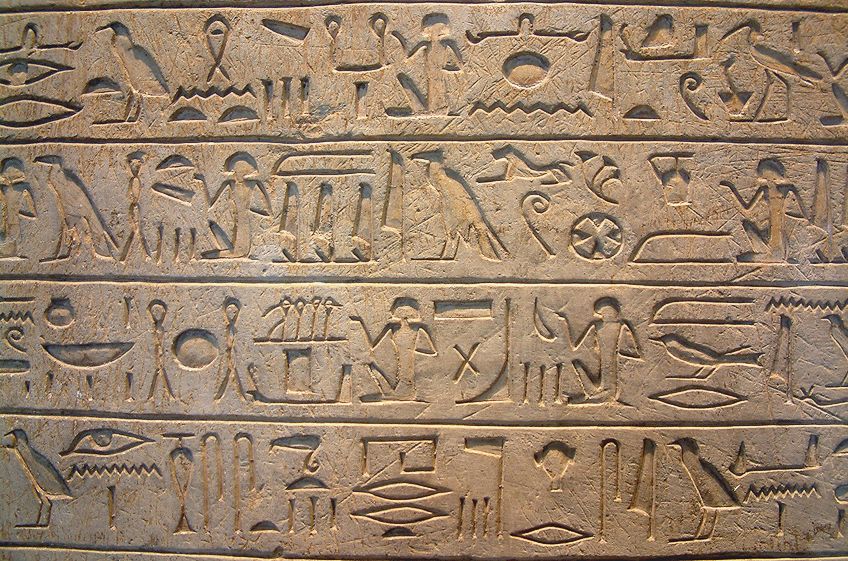 An Egyptian hieroglyphic detail of the Stele of Minnakht, main of priests at Akhmim. There are four lines of hieroglyphs: Line 1 depicts a Shen loop, spit of state, 3 strokes, a man, arms in negation, an incense bowl, and an Ibis bird. Line 2 depicts a f ield of reeds, a plinth shape, plants, and a jug with a handle. Line three depicts H-Ra-H 'block', a fence, meat, and crossed strokes. Line 4 depicts an eye, water jug, a face, and an arm with conical bread;Guillaume Blanchard, CC BY-SA 3.0, via Wikimedia Commons
An Egyptian hieroglyphic detail of the Stele of Minnakht, main of priests at Akhmim. There are four lines of hieroglyphs: Line 1 depicts a Shen loop, spit of state, 3 strokes, a man, arms in negation, an incense bowl, and an Ibis bird. Line 2 depicts a f ield of reeds, a plinth shape, plants, and a jug with a handle. Line three depicts H-Ra-H 'block', a fence, meat, and crossed strokes. Line 4 depicts an eye, water jug, a face, and an arm with conical bread;Guillaume Blanchard, CC BY-SA 3.0, via Wikimedia Commons
Hieroglyphs were too seen as artworks in and of themselves, despite these minor inscriptions not always standing for what they depicted. Traditionally, hieroglyphs were phonetic sounds that were used to explain the images they were connected to. Even so, they were sometimes logographic in nature, equally they represented the actual object and concept in word course.
Despite this, a fine line existed betwixt text and images in many cases.
This was because the name of a effigy in the text of the statue frequently left out the determinative, which was an implicit sign that aided in identification. For example, all verbs of movement were usually followed past a pair of walking legs to farther demonstrate the meaning of the hieroglyph.
The Importance of Calibration
In order to accurately convey bureaucracy inside ancient Egyptian artworks, differences in calibration stood out as the about commonly used method. Through this use of difference, i could assume that the larger the scale of the effigy, the more important that specific individual was. Every bit a issue of this, kings were most commonly shown to be the same scale as deities, as both figures were traditionally depicted as larger and more than elite than common Egyptian individuals.
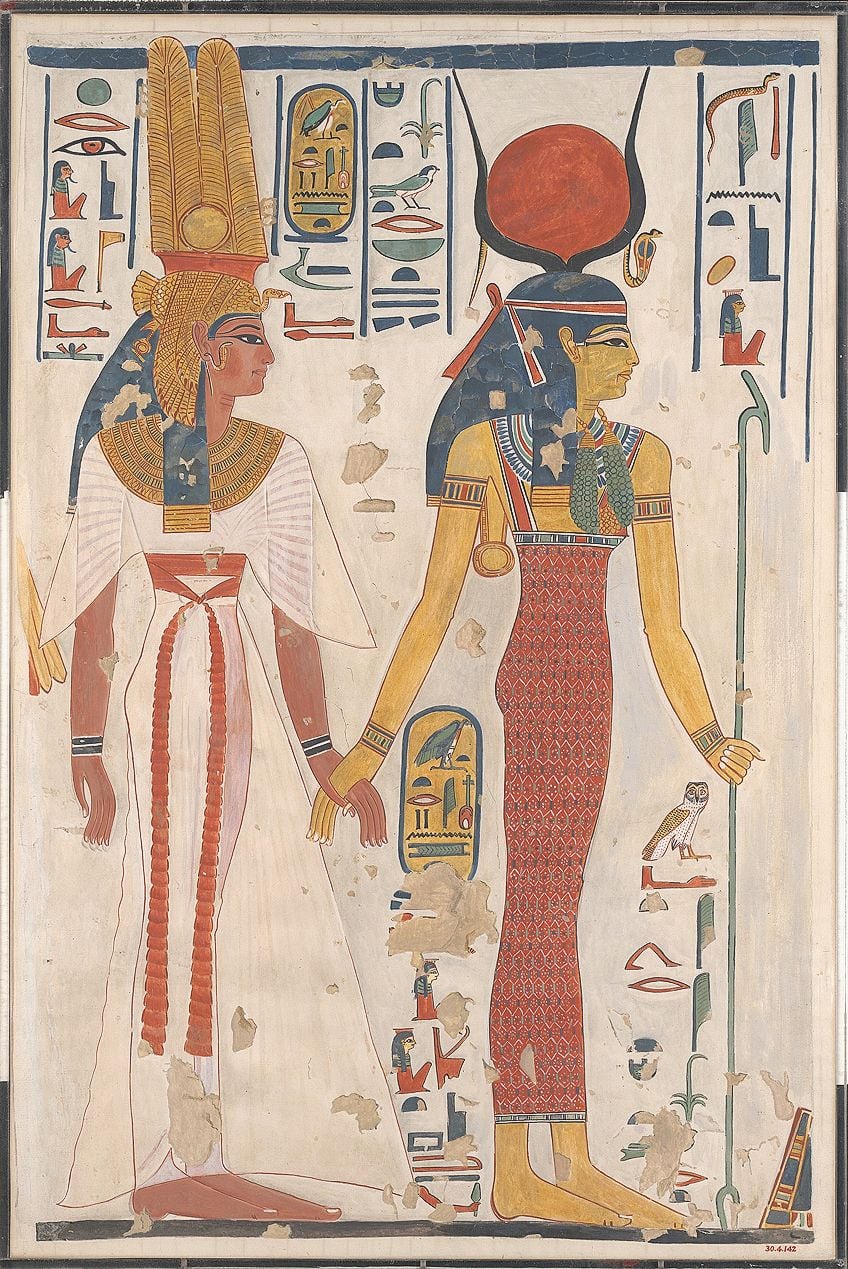 Queen Nefertari being led by Isis, the daughter of the globe god Geb and the sky goddess Nut (circa 1279 –1213 B.C.);Metropolitan Museum of Fine art, CC0, via Wikimedia Eatables
Queen Nefertari being led by Isis, the daughter of the globe god Geb and the sky goddess Nut (circa 1279 –1213 B.C.);Metropolitan Museum of Fine art, CC0, via Wikimedia Eatables
The Function of Egyptian Art
No matter what type of artworks were produced, such as statues or relief paintings, they were all intended for the same purpose. All artworks were substantially created to serve in the interest of a heavenly or departed recipient, as they provided a identify for the individual to manifest and receive the full benefits of ritual actions.
For example, the bulk of statues demonstrated a formal frontality. This meant that they were organized straight ahead so as to directly face up the ritual of saying adieu to a loved one that happened right in front of them.
No matter if statues were holy, imperial, or elite, they all worked to provide a type of channel for the spirit of the deceased that allowed them to interact with the temporal world. These statues were seen as mediators that existed between the worlds of the people and the gods, which enabled a form of advice to accept identify then that both sides were never forgotten.
The Impact of 2-Dimensional Art
Ancient Egyptian art fabricated use of both two-dimensionality besides equally three-dimensionality in the artworks that were created. As both forms differed greatly, two-dimensional fine art was said to present the nigh representative aspects of each component in the scenes as opposed to creating artworks that merely replicated the physical earth. In order to create these dazzling two-dimensional artworks, each element within a scene was depicted from its most distinguishable angle and then after grouped together in order to brand the whole.
This was why the angles of humans appeared strange, as the face, waist, and limbs were typically shown in profile while the eye and shoulders were represented frontally. Despite beingness seen every bit quite complicated, two-dimensional depictions provided consummate information about the unlike elements included to create a very comprehensive image.
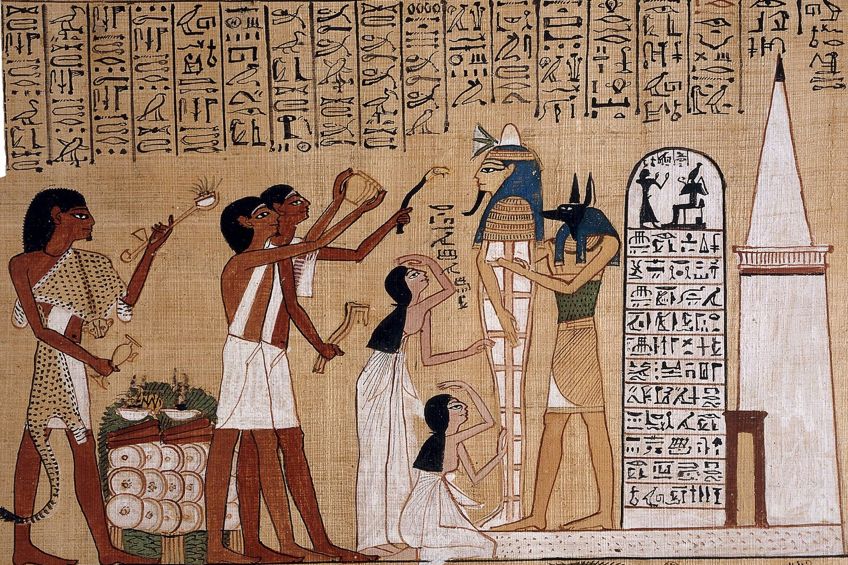 Ancient Egyptian Papyrus from the Book of the Dead of Hunefer, depicting the "opening of the oral fissure" anniversary (1275 B.C.). A more detailed explanation of the scene tin be found in the public domain The Book of the Dead, past Due east. A. Wallis Budge;Hunefer, Public domain, via Wikimedia Eatables
Ancient Egyptian Papyrus from the Book of the Dead of Hunefer, depicting the "opening of the oral fissure" anniversary (1275 B.C.). A more detailed explanation of the scene tin be found in the public domain The Book of the Dead, past Due east. A. Wallis Budge;Hunefer, Public domain, via Wikimedia Eatables
The Affect of Three-Dimensional Art
In comparison, iii-dimensional art worked to produce the most lifelike and realistic delineation of the real earth as possible. Due to this, these artworks were seen every bit very formal in nature, as statues of the gods, royalty, and the aristocracy was designed to project an arcadian and romanticized version of that individual. Aspects of naturalism were also seen, withal this depended on the type of material used every bit different materials were able to lend themselves in diverse ways to certain positions.
For example, rock statues appeared to be very closed-off and tight, as the arms of the figures were typically shown to be held close to their sides. This represented their limited room, as the only bits of space that were seen were in betwixt the areas left open between the back supporting pillar and the effigy'due south limbs.
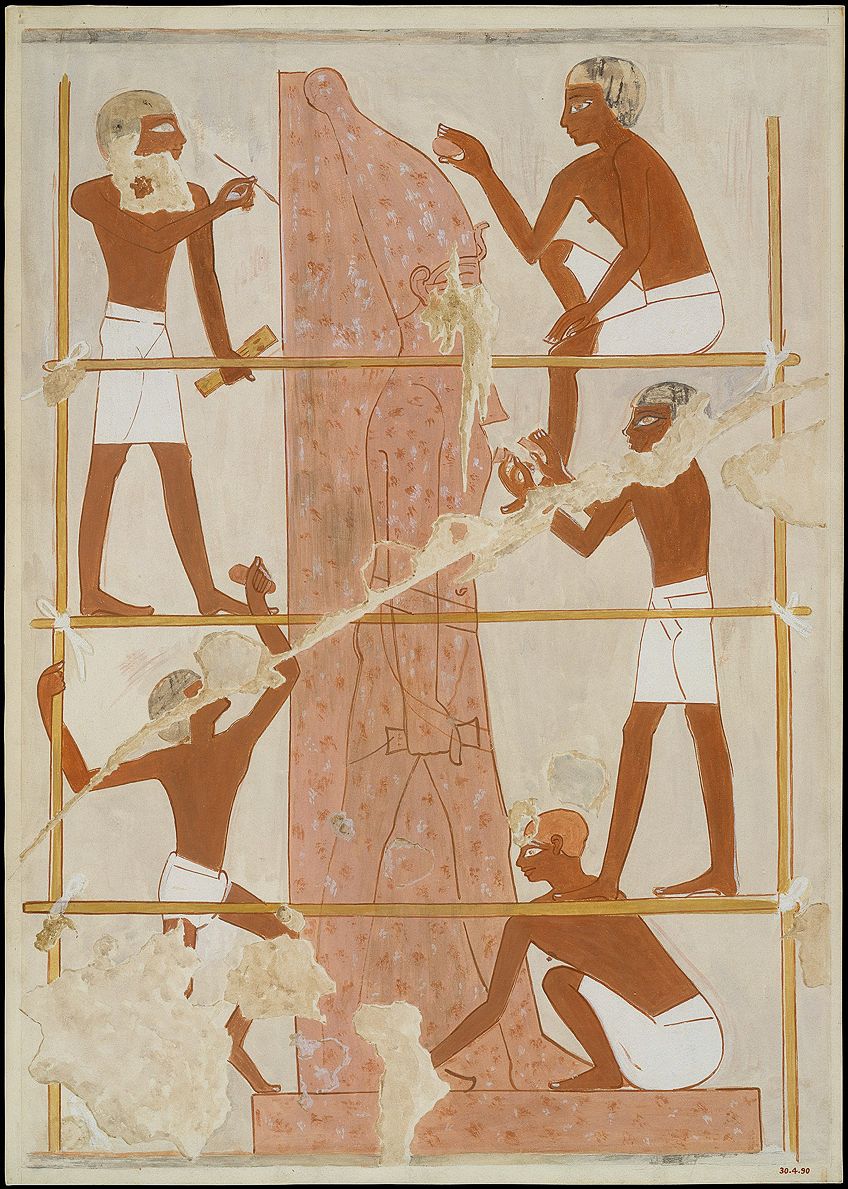 Sculptors at Work, Tomb of Rekhmire (circa 1479 –1425 B.C.);Nina Thousand. Davies, CC0, via Wikimedia Commons
Sculptors at Work, Tomb of Rekhmire (circa 1479 –1425 B.C.);Nina Thousand. Davies, CC0, via Wikimedia Commons
Past contrast, wood and metallic statues were more than expressive, equally the arms of statues were able to be extended and fully opened up. Additionally, these statues had more spaces betwixt their limbs and were even found to exist holding few objects besides, which gave them a more than realistic advent.
Despite the different materials used, all iii-dimensional statues served the aforementioned purposes and maintained an identical type of formalization and frontality.
The Chronology of Egyptian Fine art
The artworks produced in Egypt have an incredibly long history, as the majority of the pieces appointment dorsum thousands of years ago. Due to this, the two general periods that Egyptian artwork has been classified into are the pre-dynastic Egyptian art period and the early dynastic Egyptian fine art period. Beneath, we will be taking a look at the dissimilar types of art genres and cultures that made up each menses.
 Map of aboriginal Arab republic of egypt and inset map of the area around Alexandria by Abraham Ortelius, c. 1608; Folger Shakespeare Library, Public domain, via Wikimedia Commons
Map of aboriginal Arab republic of egypt and inset map of the area around Alexandria by Abraham Ortelius, c. 1608; Folger Shakespeare Library, Public domain, via Wikimedia Commons
Pre-Dynastic Egyptian Art (6000 – 3000 B.C.)
Spanning for approximately 3000 years, the pre-dynastic Egyptian art flow was made upward of three dominant cultural eras: the Merimde civilisation, the Badarian culture, and the Naqada culture. Oft compared to the Neolithic flow of art, pre-dynastic Egyptian fine art was named subsequently the various areas where sure types of Egyptian settlements were discovered.
As Egyptians began to settle along the Nile river and prefer more than of an inactive lifestyle during the Neolithic flow, very fiddling archeological evidence has been found for the years preceding 6000 B.C. However, as Egypt entered into the pre-dynastic era, more settlements began to appear, which accounted for the vast bulk of the pre-dynastic archeological artworks that were found within Upper Egypt.
Early Dynastic Egyptian Art (c. 3150 – 2686 B.C.)
As more artworks date dorsum to the early dynastic catamenia, more than data is known about this creative era in Egypt. Emerging after the affiliation of Lower and Upper Egypt around 3100 B.C., the early dynastic period is generally included as role of the Get-go and Second Dynasties, which lasted until the start of the Sometime Kingdom during 2700 B.C.
At this betoken in Egyptian art, the defining characteristics of all ancient Egyptian civilizations, including fine art, compages, and religion, began to take form during this period.
The bulk of Egyptian fine art within this period revolved effectually the themes of permanence and preservation, as artists attempted to safeguard and conserve everything in equally much of a fixed style as possible. This led artists to produce sculptures and relief paintings that portrayed gods, humans, mettlesome battles, and nature, as these were meant to provide some course of comfort to the deceased in the afterlife.
 The Narmer Palette, belonging to King Narmer in the archaic menses. A votive offering recording a history of the kind, who wears the crown of Upper Arab republic of egypt; Internet Archive Book Images, No restrictions, via Wikimedia Commons
The Narmer Palette, belonging to King Narmer in the archaic menses. A votive offering recording a history of the kind, who wears the crown of Upper Arab republic of egypt; Internet Archive Book Images, No restrictions, via Wikimedia Commons
The mutual aesthetic practices of symbolism, residuum, and symmetry that were all used to create the iconic Egyptian artworks renowned today were formalized during the early dynastic period. These values infused Egyptian paintings and sculptures from the earliest periods of art, with stone art existing as a good example of this.
During the pre-dynastic menses, stone art emerged simply was not really understood according to the ascendant artistic elements, until it was fully realized in the early dynastic period.
Artworks from the early dynastic period reached their peak in an archeological sculpture that was known as The Narmer Palette, dating betwixt 3200 and 3000 B.C.East. This artwork clearly demonstrated and celebrated the unity between Upper and Lower Egypt under King Narmer's dominion. The engravings on the slab told the story of King Narmer's victory over his enemies and how the gods supported his actions.
Characteristics of Egyptian Art
Throughout history, Egypt art has typically been known for its unique figure convention that has been used to depict the chief figures seen in both relief sculptures and paintings. Egyptian fine art has made meticulous utilize of hierarchical proportions which have gone on to characterize and identify their works as important pieces of art. This has also aided in the farther understanding of ancient Egyptian artworks, equally certain attributes exist as meaning features that define and set up their works autonomously from others.
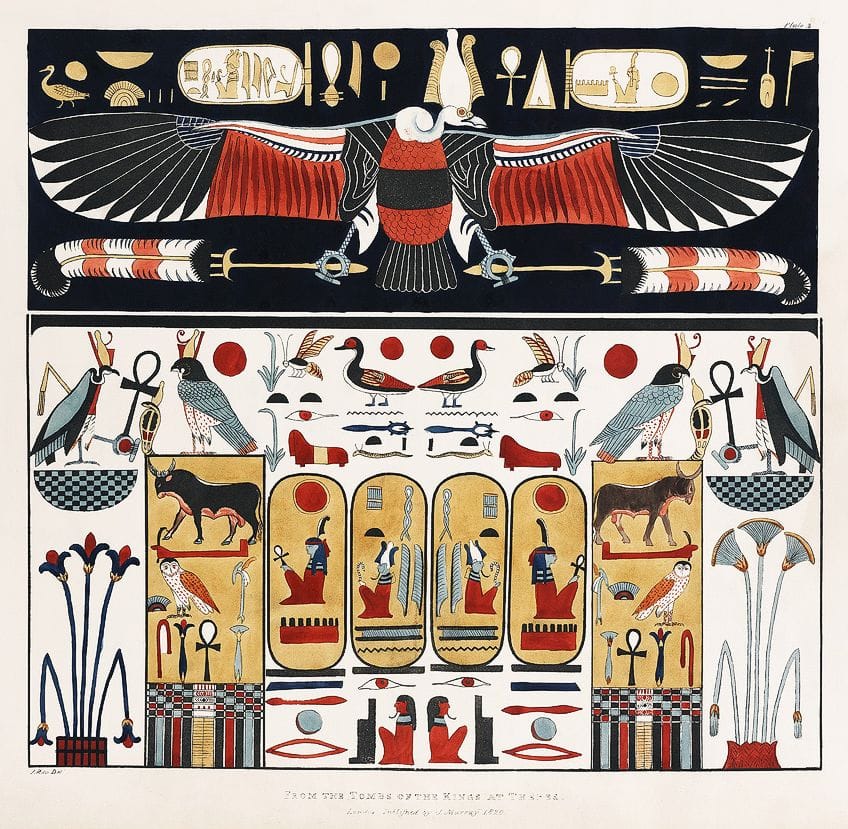
An illustration by Giovanni Battista Belzoni (1778-1823) of Plates reminiscent of the researches and operations taking place in Egypt and Nubia. The upper office represents the Eagle illustration from the king's tombs in Thebes;Gratuitous Public Domain Illustrations by rawpixel, CC By two.0, via Wikimedia Eatables
Anonymity in Egyptian Art
1 of the most prominent features of Egyptian art is that artists rarely put their names on the artworks they created. Due to this, the majority of the artists who created works during the different creative and cultural eras of Arab republic of egypt remain unknown to this mean solar day. This was mainly due to the fact that artists viewed art as serving a functional purpose as opposed to an aesthetic one, so knowing who created an artwork was seen as irrelevant by Egyptian society.
Additionally, Egyptian artwork remained mostly anonymous because it was substantially collective, as only the families who commissioned the works were able to view them.
By removing the names of artists from their works, the notion of status was taken abroad completely. Importance through art was only given to the gods and the divine pharaoh'southward through their statuary depictions, as they were typically scaled to be larger than other figures to demonstrate their say-so and authority.
Symbolism in Egyptian Art
Within ancient Egyptian art, symbolism infiltrated almost every artwork that was fabricated and went on to play a pregnant role in the establishment of gild and sense. Every aspect of Egyptian fine art, no thing if they were sculptures designed for tombs or simple yet ornate hand mirrors and cosmetic cases for everyday use, was steeped in symbolic meaning. The wealthy of Egypt had the most access to these symbolic objects and artworks, as their existence depended on the material and financial resource available to make and pay for them.
 P apyrus of Hunefer, depicting the judgment of the expressionless in the presence of Osiris (circa 1275 BCE). A more detailed explanation of the scene can be found in the public domain The Book of the Dead, by E. A. Wallis Budge;Hunefer, Public domain, via Wikimedia Commons
P apyrus of Hunefer, depicting the judgment of the expressionless in the presence of Osiris (circa 1275 BCE). A more detailed explanation of the scene can be found in the public domain The Book of the Dead, by E. A. Wallis Budge;Hunefer, Public domain, via Wikimedia Commons
The most important artworks that were infused with heavy symbolism were depictions of the pharaoh's regalia. The purpose of depicting royal attire in this way was to correspond and emphasize the great ability of the pharaoh so that guild was able to be maintained within Egyptian society.
In addition to pharaohs and their attire, goddesses, gods, and animals were also represented every bit highly symbolic figures in Egyptian art, as they were regarded as ubiquitous and almighty figures.
Colour as well served a symbolic purpose, as they tended to be very expressive. The aboriginal Egyptian linguistic communication divided color up into four basic groups, namely black, white/silver, dark-green/blue, and ruby/orangish/xanthous, with each color symbolizing a different meaning and concept. Typically, colour was used to suggest themes relating to youth, royalty, and divinity inside various artworks.
 Fragments of a sarcophagus with the deceased offerer at Anubis, III intermediate menstruum-XXI dynasty;Sailko, CC Past 3.0, via Wikimedia Commons
Fragments of a sarcophagus with the deceased offerer at Anubis, III intermediate menstruum-XXI dynasty;Sailko, CC Past 3.0, via Wikimedia Commons
Blue was said to symbolize fertility and birth, with the blueish and greenish tones existence seen every bit the colors of vegetation and renewal. Black was traditionally used to draw regal figures only, as it symbolized the fertile soil of the Nile from which Egypt arose and was also said to be associated with the afterlife and certain deities. Gold was a unique color, every bit it symbolized divinity due to its uncommon appearance and its connectedness to valuable materials and was regarded past Egyptians equally "the flesh of the god".
While near colors appeared to accept certain symbolism, cherry, orange, and yellow were regarded equally very fluctuating colors. They tended to be linked to images of the sun, with ruby-red being used as the colour of the desert, in certain gemstones that were used for imperial statues, and to write important names on documents.
Symmetry in Egyptian Art
Symmetry was the third characteristic that was considered to be important inside aboriginal Egyptian art. While these artworks were primarily motivated by the practical goal of functionality, all works needed to be aesthetically cute besides. Due to this, Egyptian art is constantly praised for its nifty beauty, which is all thanks to the value that ancient Egyptians placed on the characteristic of symmetry.
The search for perfect balance and symmetry within ancient Egyptian fine art reflected the cultural value of harmony, which was a central notion to Egyptian civilization at the fourth dimension.
In addition to being seen as a widespread notion at the time, symmetry was an ideal that came into being when the gods get-go ordered the universe. Symmetry was able to bring about the concept of unity and duality, which was represented through artworks that depicted both males and female person figures.
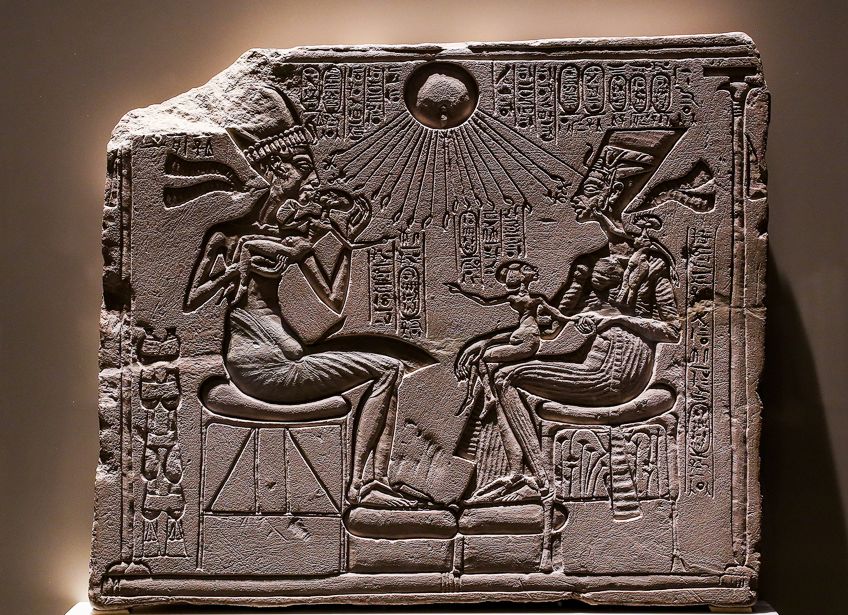 Relief of Akhenaton and Nefertiti seated, belongings three of their daughters, under the rays of the sun god Aton giving Ankh-symbols to them (ca. 1350-1340 B.C.); ArchaiOptix, CC BY-SA iv.0, via Wikimedia Commons
Relief of Akhenaton and Nefertiti seated, belongings three of their daughters, under the rays of the sun god Aton giving Ankh-symbols to them (ca. 1350-1340 B.C.); ArchaiOptix, CC BY-SA iv.0, via Wikimedia Commons
This concept of duality was essentially regulated by this harmony, with all Egyptian artworks, temples, homes, palaces, and gardens beingness created with rest in mind in order to reverberate the value of symmetry. Egyptians believed that their land was fabricated in the prototype of the world of the gods and that when someone passed abroad, they would return to an afterlife and paradise that was somewhat familiar.
Thus, all art and architectural objects were intentionally laid out to express the perfect harmony that the gods began at creation.
Types of Egyptian Art
All artworks created within ancient Egypt were done to reflect the perfection of the gods, deities, and pharaohs at the time. In addition to existing equally beautiful works of fine art, these artworks served a practical purpose on a daily basis. The most common types of Egyptian fine art that came from this era of history were Egyptian paintings, drawings, and sculptures, which we will be discussing below.
Egyptian Paintings
The majority of the surviving paintings to come from Arab republic of egypt were produced during the early dynastic period, hence the stiff emphasis on life after death that is seen. Great preservation of past knowledge is depicted in all of the ancient Egyptian artworks, with these paintings surviving thousands of years thanks to Egypt's incredibly dry climate. Another reason that Egyptian paintings have been so durable is that many of them were designed to decorate the inside of tombs, meaning that they have been well-protected for centuries.
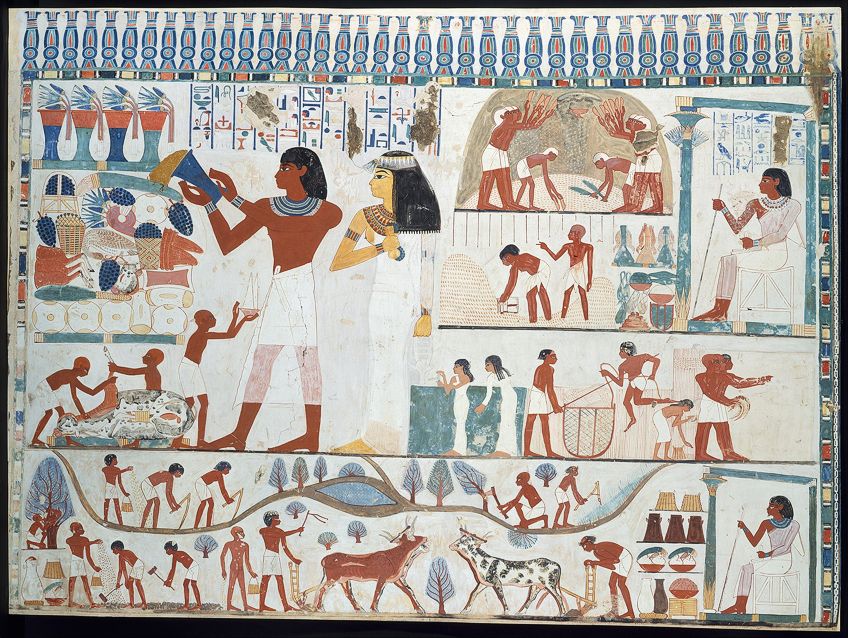 Agricultural scenes in the Tomb of Nakht (circa 1400 –1390 B.C.); Metropolitan Museum of Art, CC0, via Wikimedia Commons
Agricultural scenes in the Tomb of Nakht (circa 1400 –1390 B.C.); Metropolitan Museum of Art, CC0, via Wikimedia Commons
Despite some paintings existing for over 4000 years, the colors accept remained extremely vibrant in the works that take been found and excavated. The purpose of these paintings was to create a pleasant afterlife for the deceased in their tombs, thus the themes traditionally seen in these artworks followed the concepts of the afterlife and protective deities. Some paintings fifty-fifty showed specific activities that the person enjoyed doing that they wished to behave on doing forever.
Egyptian paintings showed off the profile and side view of the individual or animal that was existence captured.
This technique was called a blended view and was painted using specific brilliant colors, like reddish, black, blue, greenish, and gold, which was and then was mixed with egg whites then as to stick to the surface. Another technique that was a distinctive feature of Egyptian paintings was that of a sunk relief, which was used in more prestigious tomb works. These reliefs were well-suited to bright sunlight as they could withstand the strong sun without fading over time.
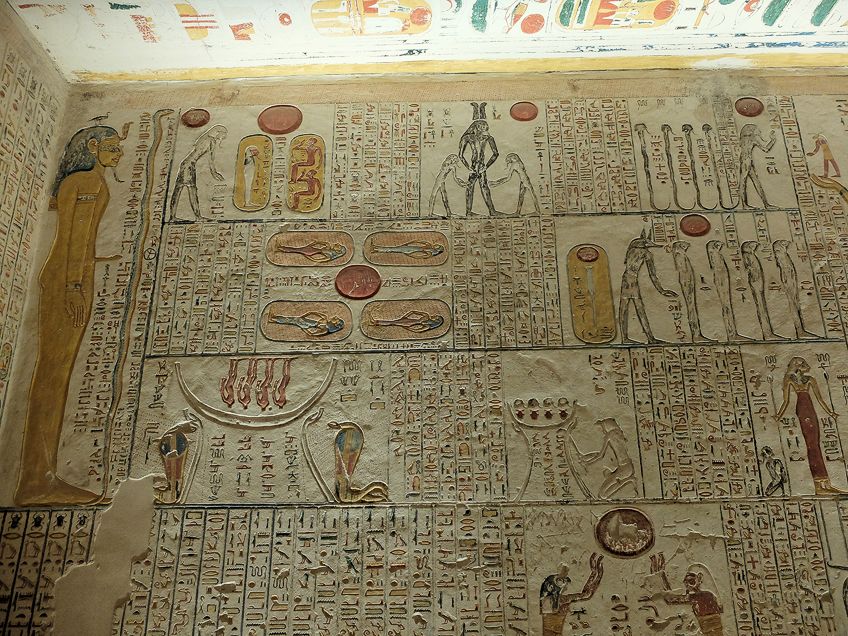 KV9 Tomb of Ramses 5-Six. Fourth corridor, decoration on right wall: fifth section of the Book of Caverns (left side, the book continues off-frame to the correct);R Prazeres, CC BY-SA four.0, via Wikimedia Eatables
KV9 Tomb of Ramses 5-Six. Fourth corridor, decoration on right wall: fifth section of the Book of Caverns (left side, the book continues off-frame to the correct);R Prazeres, CC BY-SA four.0, via Wikimedia Eatables
The relief paintings establish within tombs were both high reliefs, where figures stood out from the wall, and low reliefs, where figures were really carved into the wall. In lodge to create these types of paintings, the surface would be smoothed over and sanded. Artists would showtime create a miniature to refer dorsum to earlier drawing grid lines onto the wall and then as to replicate their piece of work.
These paintings would first be outlined in cherry paint, with corrections by other artists existence washed in black paint, earlier the final artwork was created.
Egyptian Drawings
One of the virtually well-known types of drawings to come out of ancient Egypt was hieroglyphics. Existing as a form of pictorial writing and drawing, hieroglyphics had an inherent sense of aesthetic beauty. These symbols were typically used on aboriginal Egyptian monuments as a fashion to describe what the artwork meant. However, instead of acting as a direct translation of what the object was, hieroglyphics stood for specific sounds and groups of sounds in order to explicate a work.
As they were seen as beautifully intricate, hieroglyphics are easily classified as another type of Egyptian drawings. Despite their uncomplicated form, hieroglyphics were an incredibly complex class of drawing and writing. Sentences could either start from the left or correct and be read from the top or bottom depending on how it would affect the elegance of the completed artwork.
 Ancient Egyptian hieroglyphs depicting the coming together notes of the 4th coming together of the 12;Camshea, CC BY-SA 4.0, via Wikimedia Commons
Ancient Egyptian hieroglyphs depicting the coming together notes of the 4th coming together of the 12;Camshea, CC BY-SA 4.0, via Wikimedia Commons
Due to the fact that Egyptian hieroglyphics were then confusing to read, an piece of cake connectedness betwixt the traditional alphabet and the hieroglyphic symbols could not be made, every bit they encompassed two completely different languages. Over fourth dimension, many historians have come up upward with a simplified translation of Western messages to hieroglyphics, so some sense and agreement can be drawn from these artworks.
Thus, every fourth dimension a discussion was spelled out, these drawings would be used to convey the information to those reading the hieroglyphics.
Egyptian Sculpture
Nearly Egyptian sculpture was created during the early dynastic period. Sculptures were typically carved as both sunken and low reliefs, as they adhered to the same conventions that governed Egyptian painting and were able to withstand the force of the lord's day. Figures who are not seated in sculptures were characteristically portrayed with parted legs, their heads in profile, and their torsos turned to directly face individuals. This was considering they were made to directly confront the rituals beingness conducted before them in tombs.
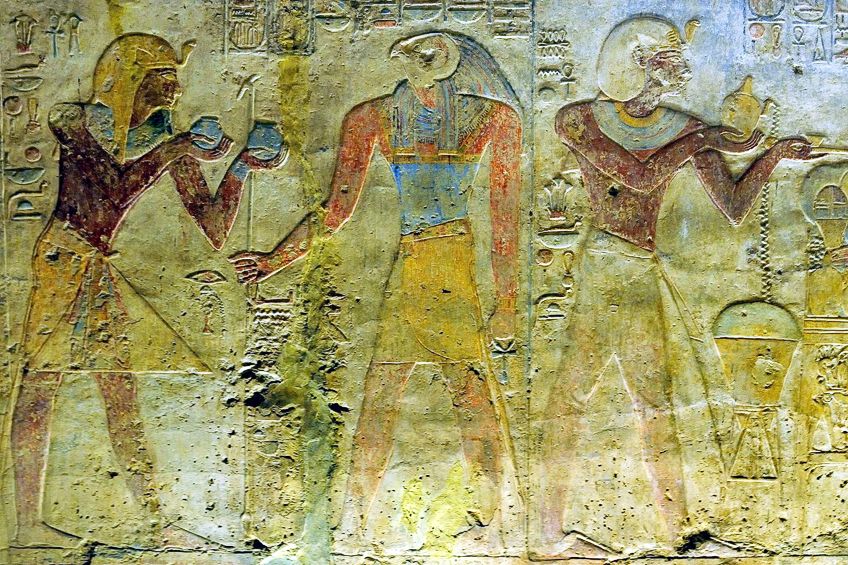 A relief of pharaoh Ramesses Ii making an offering to Horus from the Temple of Beit el-Wali in Nubia;https://world wide web.flickr.com/photos/rivertay/, CC BY-SA ii.0, via Wikimedia Eatables
A relief of pharaoh Ramesses Ii making an offering to Horus from the Temple of Beit el-Wali in Nubia;https://world wide web.flickr.com/photos/rivertay/, CC BY-SA ii.0, via Wikimedia Eatables
Strict rules were followed when crafting statues, every bit every god had rules for how their appearance was depicted. For example, the god of the sky, Horus, was always depicted with a falcon'south head no matter who carved him. As all artists had to follow the aforementioned rules, their works were ranked according to their conformity with these features. Due to these rules hardly irresolute, the appearance of Egyptian sculptures did non change in over 3000 years. This was also intended to convey the permanence and non-aging qualities of the gods.
However, out of all the sculptures ever made, the about iconic ones to come up from aboriginal Egypt were indeed the inexplicable Neat Pyramids.
Continuing on a natural stone shelf that is known every bit the Giza plateau today, these pyramids have existed as burying places, memorials, and sites of worship for deceased rulers. Out of the pyramids that were constructed, 3 are deemed to be the about important. The largest was made for King Khufu, the middle-sized one was made for his son, Khafre, and the smallest belonged to his grandson, Menkaure.
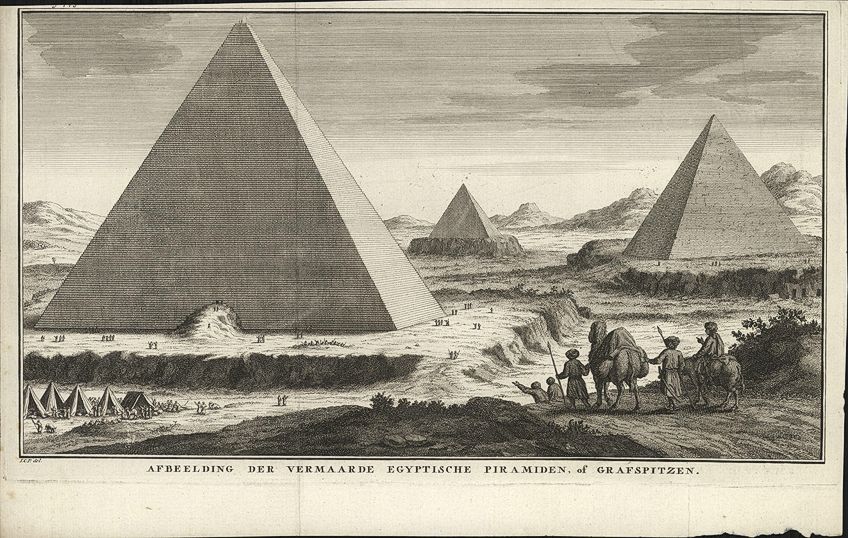 Photograph of the famous Great Pyramids of Giza;Jan Caspar Philips (tekenaar) onbekend (graveur), Public domain, via Wikimedia Commons
Photograph of the famous Great Pyramids of Giza;Jan Caspar Philips (tekenaar) onbekend (graveur), Public domain, via Wikimedia Commons
Iconic Egyptian Artwork
Throughout history, many astounding Egyptian artworks accept been unearthed in diverse temples and tombs. Due to the extensive archeological excavations that have occurred in Egypt throughout the decades, with these digs supposedly dating back to the mid-1880s, very comprehensive collections of Egyptian artworks take been put together. Out of all these artifacts that have been found, the near iconic Egyptian artworks to e'er be remain the pyramids, with worldwide fascination surrounding these structures constantly growing.
The Cracking Pyramids of Giza
Classified as one of the 7 wonders of the ancient world, the great pyramids of Giza are perhaps the almost renowned and talked-about structures in history. For thousands of years, these gigantic monuments were unmatched in height, as individuals marveled over their unique and complicated structure, as they seemed almost also perfect to be real.
Research has shown that the construction of the pyramids of Giza was the event of trial and error, with its success representing the peak in the development of the purple mortuary complex.
Every bit they were intended for the rulers of Egypt, they were built over the bridge of 3 generations for the pharaoh'due south Khufu, his son Khafre, and his grandson Menkaure. The proximity of these pyramids to one another was important, as being buried near the pharaoh was seen as an farthermost award and supposedly ensured an esteemed identify in the afterlife.
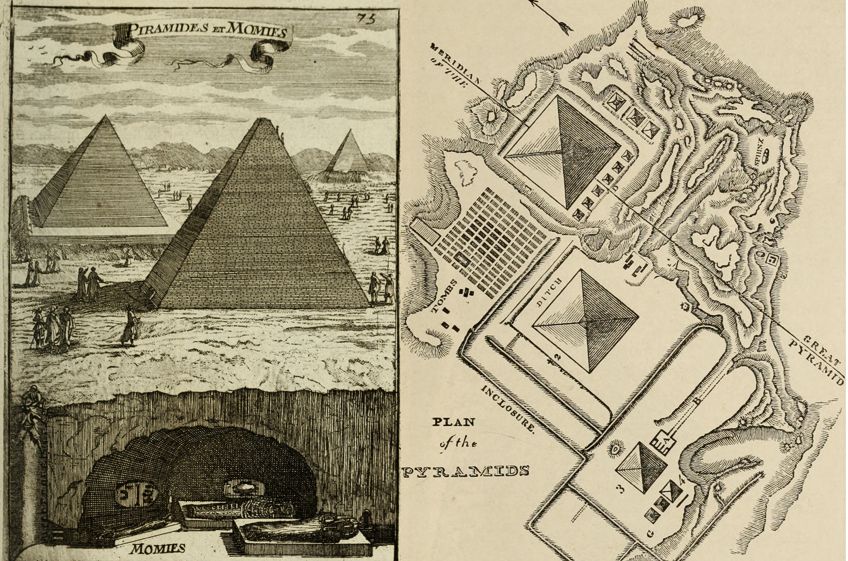
The Bully Pyramids of Giza. LEFT: Analogy fromDescription de l'univers (1683) depicting the Corking Pyramids aboveground and 1 of the many tombs beneath; Internet Archive Book Images, No restrictions, via Wikimedia Commons. Right: A plan of the three Great Pyramids of Giza, illustrating their proximity to one some other, from the Handbook of Archaeology (1867);Net Archive Book Images, No restrictions, via Wikimedia Commons
Throughout the decades, many questions have remained about the construction of these pyramids. The discovery of a town for workers to the south of the Giza plateau has provided some answers, equally the individuals were thought to make up the permanent group of craftsmen and builders who worked on the pyramids. It has been estimated that roughly twenty 000 workers helped build the pyramids, with about 340 small stones being moved daily from the quarry to the construction site during the xx years information technology took to complete.
The shape of the pyramids of Giza was thought to be a reference to the sun and the bending of its rays. The final point on top of the construction was seen equally a ramp for the pharaoh to mount into the sky. Despite their jumbo size, the pyramids are unfortunately not permanent.
With the rapid growth that Cairo is experiencing, these structures will need increased consideration and safeguarding if they are to remain intact as vital benchmarks of ancient Egyptian art.
Pyramid of Khufu
Likewise chosen the Groovy Pyramid, the largest of the Giza pyramids was intended for Pharaoh Khufu. With a height of 146 meters and a base length of more than than 230 meters per side, the pyramid of Khufu is regarded as an phenomenal engineering achievement. What makes this pyramid so fascinating is its inner and outer casting stones, with an estimated 2 300 000 blocks of stone weighing up to fifty tons thought to have been used.
Following his predecessors, the pyramid of Khufu was made up of rough inner stones that were locally quarried and laid horizontally with spaces that were later filled with plaster. While originally built with outer casting stones, these take since been advisedly removed, along with a capstone that used to sit down at the very top point of the pyramid. Unfortunately, both the outer stones and the capstone would accept fabricated the pyramid visible from a greater altitude if they were still there today, every bit they would have dazzled in the intense sunlight.
 Entrance to the Pyramid of Khufu, including a labeled diagram showing the interior chambers and passageways of the pyramid besides as their dimensions;William Vaughn TupperFlickr uploader BPL, Public domain, via Wikimedia Commons
Entrance to the Pyramid of Khufu, including a labeled diagram showing the interior chambers and passageways of the pyramid besides as their dimensions;William Vaughn TupperFlickr uploader BPL, Public domain, via Wikimedia Commons
The interior passageways of the pyramid of Khufu add together to its uniqueness, every bit diverse puzzling features exist within this structure. One of these features is an unfinished bedroom whose function remains unknown, and several "air shafts" that fan out from the upper chambers. In recent times, these peculiarities have been explored through the utilize of small robots, but a series of blocking stones have prevented farther investigation into certain passages.
When inbound the pyramid, one has to climb up a narrow ascending chamber that opens into the Grand Gallery.
One time here, a passage leads into the King's Sleeping accommodation that was made entirely from blood-red granite. Here, Khufu'south sarcophagus, which was sculpted from red granite, was found at the central axis of the pyramid. Additionally, seven large brick-lined boat pits were located in the pyramid of Khufu, which were idea to transport the King to outstanding destinations in his afterlife.
Pyramid of Khafre
The second swell pyramid, known every bit the pyramid of Khafre, was congenital past Pharaoh Khufu'south second son, Khafre. Existing as quite a large structure, the pyramid of Khafre initially appeared larger than that of his father's simply is in fact somewhat smaller. The reason for its gigantic advent was that it was actually constructed virtually 10 meters college on the Giza plateau than both of the other two swell pyramids.
Due to this, the interior of the pyramid is much smaller and simpler than the pyramid of Khufu. Only a single burial sleeping accommodation was built, forth with 1 small secondary chamber and ii passageways. However, the place that the pyramid of Khafre appears to be more complex in blueprint is in the mortuary temple at the base of operations, as information technology exists as the more intricate construction when compared to the pyramid of Khufu.
 Cross-Section of the Pyramid of Khafre;Agostiono Aglio, Public domain, via Wikimedia Commons
Cross-Section of the Pyramid of Khafre;Agostiono Aglio, Public domain, via Wikimedia Commons
Inside the base, more than 52 statues of Khafre were establish which filled the available space. These sculptures and images were either depicted as life-sized or larger, which represented the true prominence of the king. Upon earthworks, statue bases indicated that an extra 24 images of the pharaoh were originally placed in this temple only were no longer there.
Due to its location at the east end, the pyramid's valley temple has been stunningly protected and maintained over time.
Pyramid of Menkaure
The third pyramid that fabricated upwardly the trio of the great pyramids of Giza belonged to Menkaure, the son of Khafre and the grandson of King Khufu. Every bit it is the smallest of the three structures, the top of the pyramid merely reaches 65 meters. Despite this, the pyramid of Menkaure has managed to preserve some of the most beautiful examples of sculpture to come up from Egyptian history today.
The chambers of the pyramid of Menkaure are known to be more complex than the chambers in the pyramid of Khufu. This is because they include a chamber that was sculpted with decorative panels and another chamber with six large alcoves. The burying bedroom, which housed Menkaure's embalmed body was lined with gigantic granite blocks, with his sarcophagus being carved with hollow panels as well.
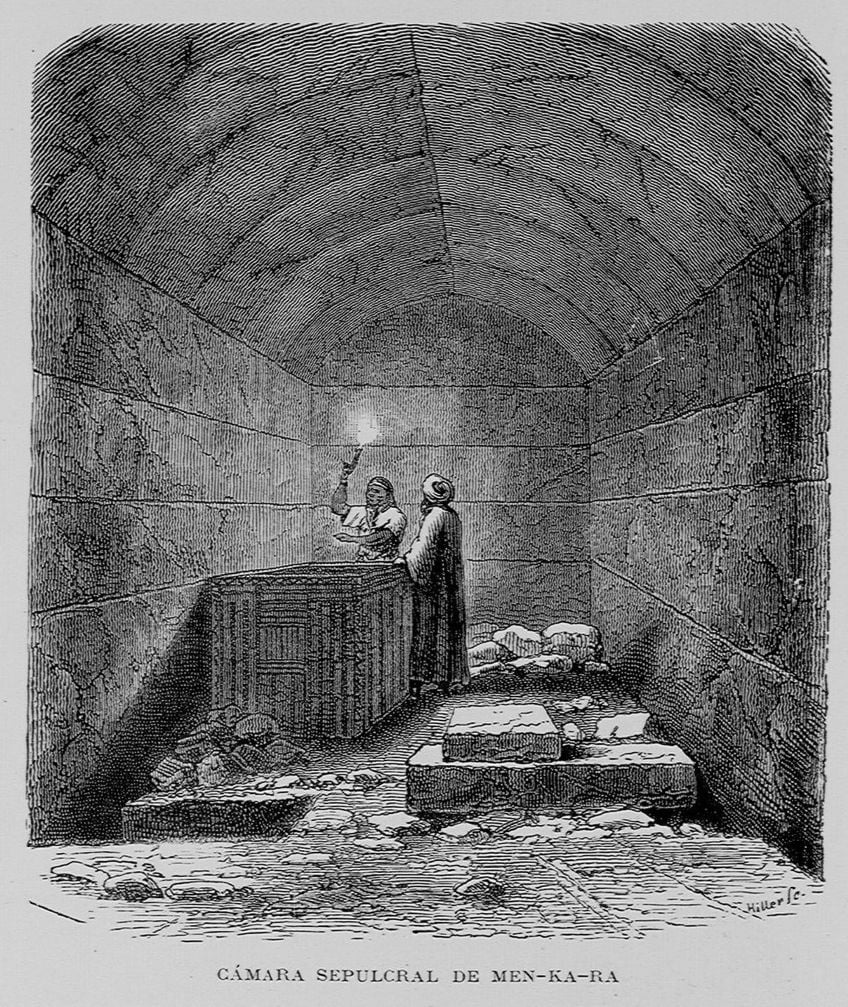 Tomb Chamber of Men-Ka-Ra! (1882), illustrated by Karl Werner (1881-1888);Fondo Antiguo de la Biblioteca de la Universidad de Sevilla from Sevilla, España, CC By 2.0, via Wikimedia Commons
Tomb Chamber of Men-Ka-Ra! (1882), illustrated by Karl Werner (1881-1888);Fondo Antiguo de la Biblioteca de la Universidad de Sevilla from Sevilla, España, CC By 2.0, via Wikimedia Commons
While Menkaure'southward pyramid was being excavated, it was discovered that neither his mortuary nor valley temples were ever completed before he died. Inside these chambers, a series of statues of the king were found, including a magnificent diad of him with his main queen, Khamerernebty Two, and various triads that depicted Menkaure being embraced by several deities.
The story of Menkaure's sarcophagus is an interesting one, equally it was considered to be an important discovery when it was get-go found. However, while it was being transported back to England by boat, the sarcophagus was lost at body of water during a storm. This has led to Menkaure being considered as ane of history's nigh of import vanished treasures today. Additionally, the actual structure of the pyramid faced serious damage after a overflowing at the finish of the 6th dynasty and was almost entirely rebuilt.
The Great Sphinx
Carved from the bedrock of the Giza plateau is the Bully Sphinx, which is the 4500-year-old limestone statue that sits near the entrance to the great pyramids leading from Khafre's valley temple into the mortuary. Measuring 20 meters loftier and 73 meters long, the Great Sphinx exists equally one of the world's largest and near iconic monuments, in addition to being one of the most identifiable relics constructed by the ancient Egyptians.
Within ancient history, a sphinx was a creature that had the body of a panthera leo and the head of a human.
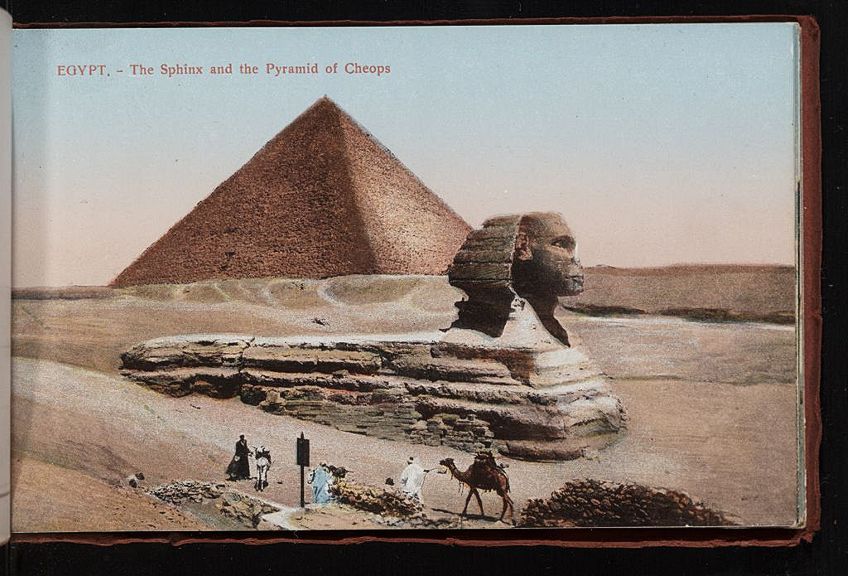 A postcard depicting the Sphinx and the Pyramid of Cheops;B. Livadas & Coutsicos, CC By-SA 2.v, via Wikimedia Eatables
A postcard depicting the Sphinx and the Pyramid of Cheops;B. Livadas & Coutsicos, CC By-SA 2.v, via Wikimedia Eatables
Existing as a prominent figure in Egyptian, Asian, and Greek mythology, the Great Sphinx is steeped in legend and folklore. In Egyptian history, a sphinx was idea to be a spiritual guardian and was mostly portrayed as a male wearing a pharaoh headdress. Due to its proximity to Khafre's pyramid and its slight resemblance to the pharaoh, the Great Sphinx was said to have been carved specifically for the rex to offer protection.
As the pyramid of Khafre was surrounded by the great Sphinx and other statues, some scholars have stated that a celestial purpose explains the location of the Smashing Sphinx to Khafre's mortuary. Equally the lion was a royal symbol that was connected to the sun, it has been suggested that the Corking Sphinx was in that location to resurrect the soul of Khafre by channeling the ability of the sun and other gods. Despite being simply a theory, this provides a plausible explanation for the construction'southward closeness to the pyramid.
![]() A photograph of the Sphinx in Cairo;New York Public Library, No restrictions, via Wikimedia Eatables
A photograph of the Sphinx in Cairo;New York Public Library, No restrictions, via Wikimedia Eatables
The Bang-up Sphinx exists equally one of the about interesting aboriginal Egyptian artworks, as then much is withal speculated near it.
It has been debated that the Sphinx is actually far older than what is widely believed, based on the patterns of erosion nowadays on the structure. Additionally, as the word "sphinx" only originated in Greek mythology about 2000 years later on the construction's completion, information technology remains unknown as to what the ancient Egyptian's called it.
Tutankhamun's Tomb
Ane of the most popular stories of ancient Arab republic of egypt was the story of Tutankhamun becoming pharaoh at the age of merely nine years former. Discovered in 1922, the excavation of Tutankhamun'southward tomb in the Valley of the Kings is seen every bit ane of the most valuable archeological sites that take been found in Arab republic of egypt. However, the story of Tutankhamun was near completely lost to history equally the archeologist, Howard Carter, who discovered his tomb ran out of fiscal backing and almost did non excavate at this site.
Upon discovery, the tomb was nearly intact and was home to a wealth of objects.
These finds have given historians and scholars an even closer and more unique insight into this specific period of the 18thursday dynasty of the New Kingdom when King Tutankhamun ruled. His time ruling Arab republic of egypt was rather circuitous and brusque-lived, every bit Tutankhamun married his half-sister Ankhesenamun, did not produce any heirs, and died at the immature age of eighteen. Manners of his death accept been widely speculated and today, the answer remains a mystery still.
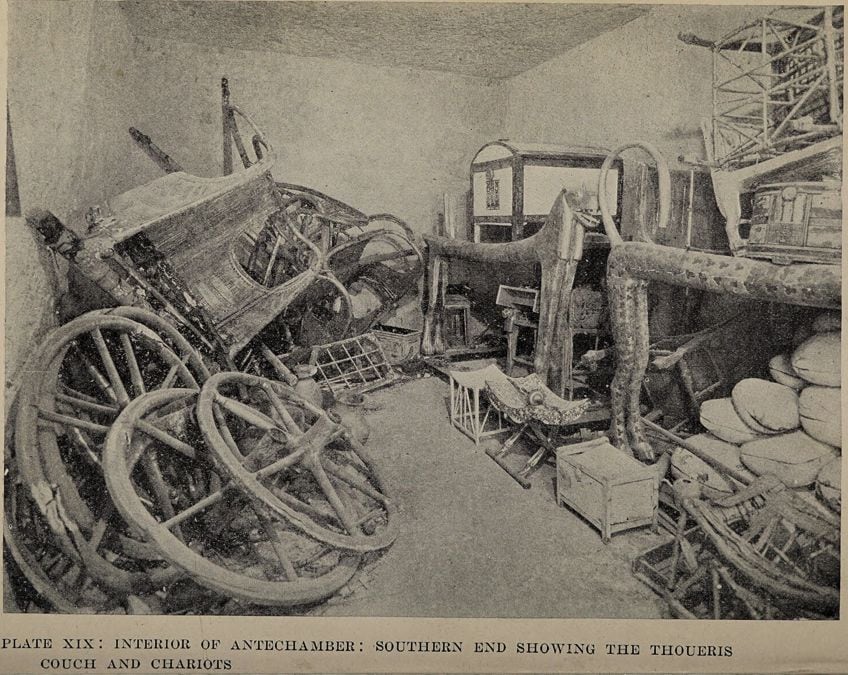 Illustration from the Tomb of Tut-Ankh-Amen, Plate XIX, Interior of the Antechamber, Southern End Showing the Thoueris Couch and Chariots, by Howard Carter and A. C. Mace, illustrations and photographs past Harry Burton, 1923;Harry Burton (illustrator & photographer), Public domain, via Wikimedia Commons
Illustration from the Tomb of Tut-Ankh-Amen, Plate XIX, Interior of the Antechamber, Southern End Showing the Thoueris Couch and Chariots, by Howard Carter and A. C. Mace, illustrations and photographs past Harry Burton, 1923;Harry Burton (illustrator & photographer), Public domain, via Wikimedia Commons
Tutankhamun'southward tomb was robbed and resealed twice afterward it was initially completed, with these robberies apparently hurrying up the structure of the tomb. Due to this, the tomb was constitute to be densely packed with items in peachy disorder equally it was small in size, as the robberies forced workers to seal the structure virtually immediately. Said to have been entered two more times subsequently his mummy was buried, rumors have circulated about the "Curse of the Pharaoh" that face intruders who attempt to violate the male monarch's concluding resting place.
Information technology took 8 years to fully empty Tutankhamun's tomb due to the sheer number of objects plant and Carter's meticulous recording procedure.
Within his sarcophagus, an innermost coffin was found, as three coffins held the trunk of Tutankhamun. The outer two coffins were made from wood and coated in aureate and semiprecious stones, including lapis lazuli and turquoise. The innermost bury proved to exist the about improvident and valuable, as information technology was bandage in solid gold.
When the coffin was originally institute, it was not the shiny golden image that we know today. Carter wrote in his notes that the bury appeared to be covered in a thick black layer from the easily down to the ankles. This was an anointing liquid, which was poured over during the burial to preserve it. Perhaps the most iconic object institute within the tomb was the death mask of Tutankhamun. Seen as one of the masterpieces of ancient Egyptian art, the mask originally rested on the shoulders of the mummy of Tutankhamun inside the gold coffin.
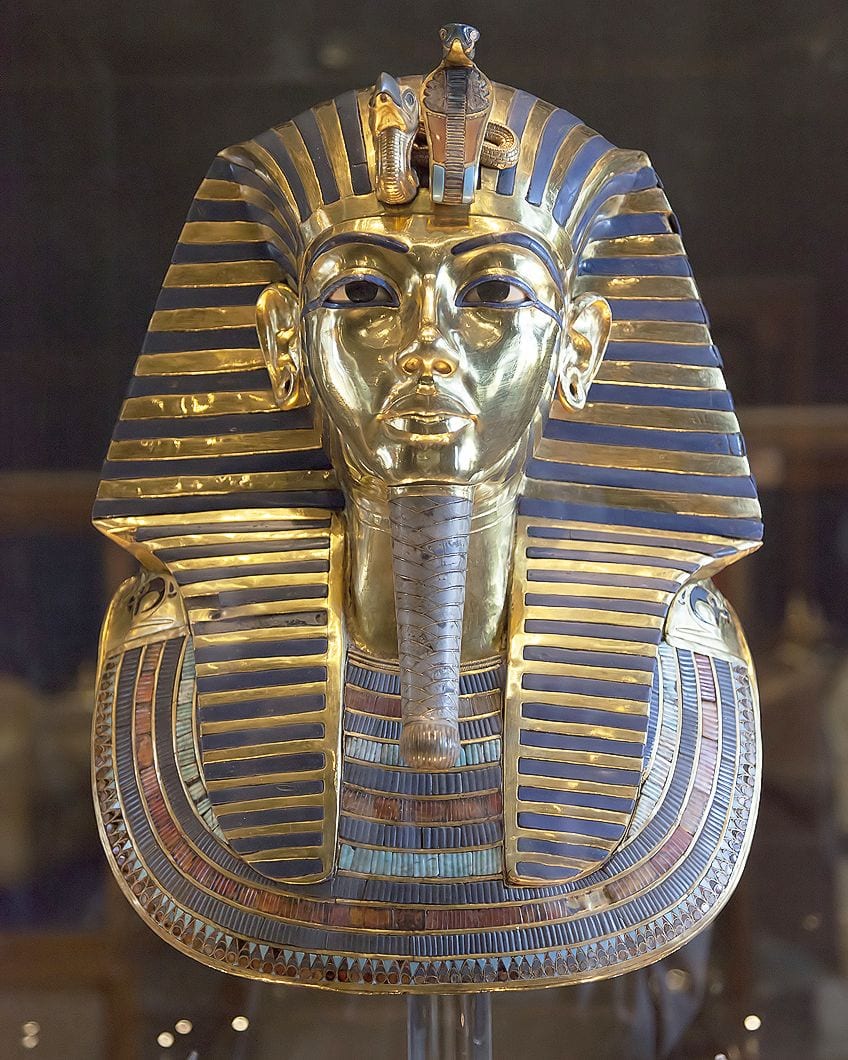 The Mask of Tutankhamun, c. 1327 BC. Fabricated of gilt, glass and semi-precious stones with a meridian of 54cm. It is currently existence housed in the Egyptian Museum (Cairo);Roland Unger, CC By-SA iii.0, via Wikimedia Eatables
The Mask of Tutankhamun, c. 1327 BC. Fabricated of gilt, glass and semi-precious stones with a meridian of 54cm. It is currently existence housed in the Egyptian Museum (Cairo);Roland Unger, CC By-SA iii.0, via Wikimedia Eatables
The mask portrays Tutankhamun to be wearing a striped cloth Nemes headdress, which was traditionally worn by pharaohs in aboriginal Arab republic of egypt, with the goddesses Nekhbet and Wadjet shown to be protecting his forehead. The false beard that is seen was said to connect Tutankhamun to the epitome of a god, with the back of the mask being covered with Spell 151b from the Book of the Dead. This was used by ancient Egyptians equally a guideline for the afterlife and was used to protect the torso of Tutankhamun as he moved into the underworld.
Influence and Legacy of Egyptian Art
Aboriginal Egyptian art existed as an incredibly of import flow of art that went on to influence the European understanding, technique, and fashion which would be observed for the next 1000 years or and so. The features and characteristics that are taken from Egyptian art merely demonstrated a change in the late xixth and early xxth century, when Italian artists formed the futurist grouping and began to separate themselves from past ideals.
The beginning of modern art in society forced individuals to recognize the preconceptions that existed effectually art so that a intermission from past styles and techniques could begin.
This led to some Egyptian fine art coming nether criticism as it was considered to be unpolished co-ordinate to new standards, despite being famously adored and respected for so many years prior. Some critics went every bit far as to say that Egyptians never truly learned the chemical element of perspective, as no interaction of light and shadow was seen in the artworks found.
 Facsimile of a vignette from the Book of the Dead of Ani. The deceased Ani kneels earlier Osiris, judge of the dead. Behind Osiris stand his sisters Isis and Nephthys, and in front of him is a lotus on which stand the four sons of Horus. Scanned from The Egyptian Volume of the Dead: The Book of Going Forth by Day past James Wasserman et al (1994), facsimile created 1890; original artwork created c. 1300 BC;British Museum, Public domain, via Wikimedia Commons
Facsimile of a vignette from the Book of the Dead of Ani. The deceased Ani kneels earlier Osiris, judge of the dead. Behind Osiris stand his sisters Isis and Nephthys, and in front of him is a lotus on which stand the four sons of Horus. Scanned from The Egyptian Volume of the Dead: The Book of Going Forth by Day past James Wasserman et al (1994), facsimile created 1890; original artwork created c. 1300 BC;British Museum, Public domain, via Wikimedia Commons
Additionally, other Egyptian artwork began to exist targeted equally the globe of fine art started to move in a completely new direction, equally works were seen as ii-dimensional and emotionless. Even iconic statues that were previously praised, such as sculptures depicting battle scenes, kings, and queens, were labeled equally impassive and cold and therefore not plumbing fixtures for the new genre of art.
However, what these critiques failed to recognize was the functionality of Egyptian art. Artists understood the importance of emotions, but also knew that they were a temporary land. Thus, depicting statues and paintings with i unmarried emotion would have led to an inauthentic artwork existence created equally individuals were not consistently happy or sad, and a false scene would remainder in one's tomb for all eternity. Due to this, Egyptian fine art demonstrated an elevated knowledge about including the transient nature of emotion in artworks.
In essence, Egyptians saw life every bit only the smaller part of an eternal journey that all individuals would embark on, with Egyptian fine art accurately reflecting these beliefs. This led to artworks that were made to withstand the examination of fourth dimension, allowing society today to await back at and consider artworks that existed thousands of years ago. The influence of Egyptian art on the current artistic society has proved to be invaluable, as the values and beliefs of Egyptian artists accept gone on to inform the basic premise of what art stands for today.
Take a expect at our ancient Egyptian art webstory here!
Oftentimes Asked Questions About Egyptian Fine art
What Is Egyptian Art?
Dating back to the pre-dynastic menstruation, Egyptian art has developed for thousands of years within Egypt. Initially, art was reserved for the wealthy elite and the pharaohs who ruled Arab republic of egypt, significant that only those who could beget artworks had access to them. Existing equally an art grade that primarily served a purpose, Egyptian art prioritized function over artful dazzler as art was made to help those who passed away forth the journeying of entering into their eternal afterlife.
What Were the Important Characteristics of Egyptian Art?
Every bit artworks were made for a specific objective, Egyptian artists generally made utilise of the same important characteristics within their works then every bit to accurately attain their desired goal. These characteristics included the utilization of anonymity, symmetry, and symbolism. If all of these elements were effectively combined, artworks that were truly Egyptian in style were considered to exist made.
What Are Some of the Most Famous Examples of Egyptian Fine art?
Some of the most iconic examples of Egyptian art are the sculptural figures and objects that were made. These include the great pyramids of Giza, the pyramid of Khufu, the pyramid of Khafre, the pyramid of Menkaure, the Cracking Sphinx, and Tutankhamun'south tomb.
valtierrautmacksmay.blogspot.com
Source: https://artincontext.org/egyptian-art/
0 Response to "Art of the Egypt 1500 Bce Art of the Greece 1000 Bce"
Post a Comment